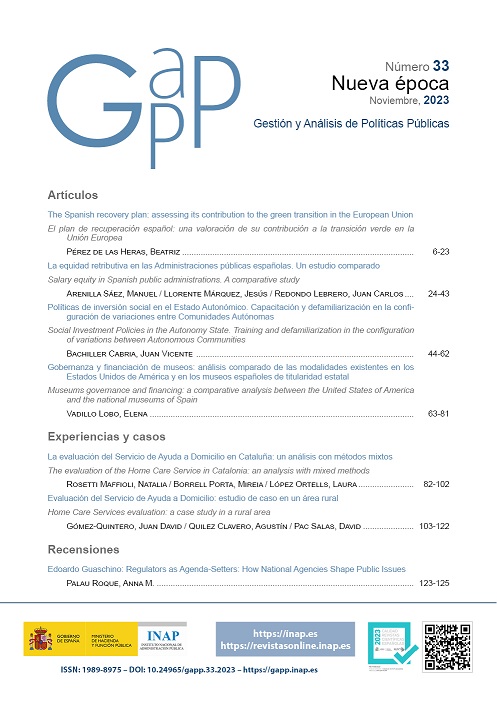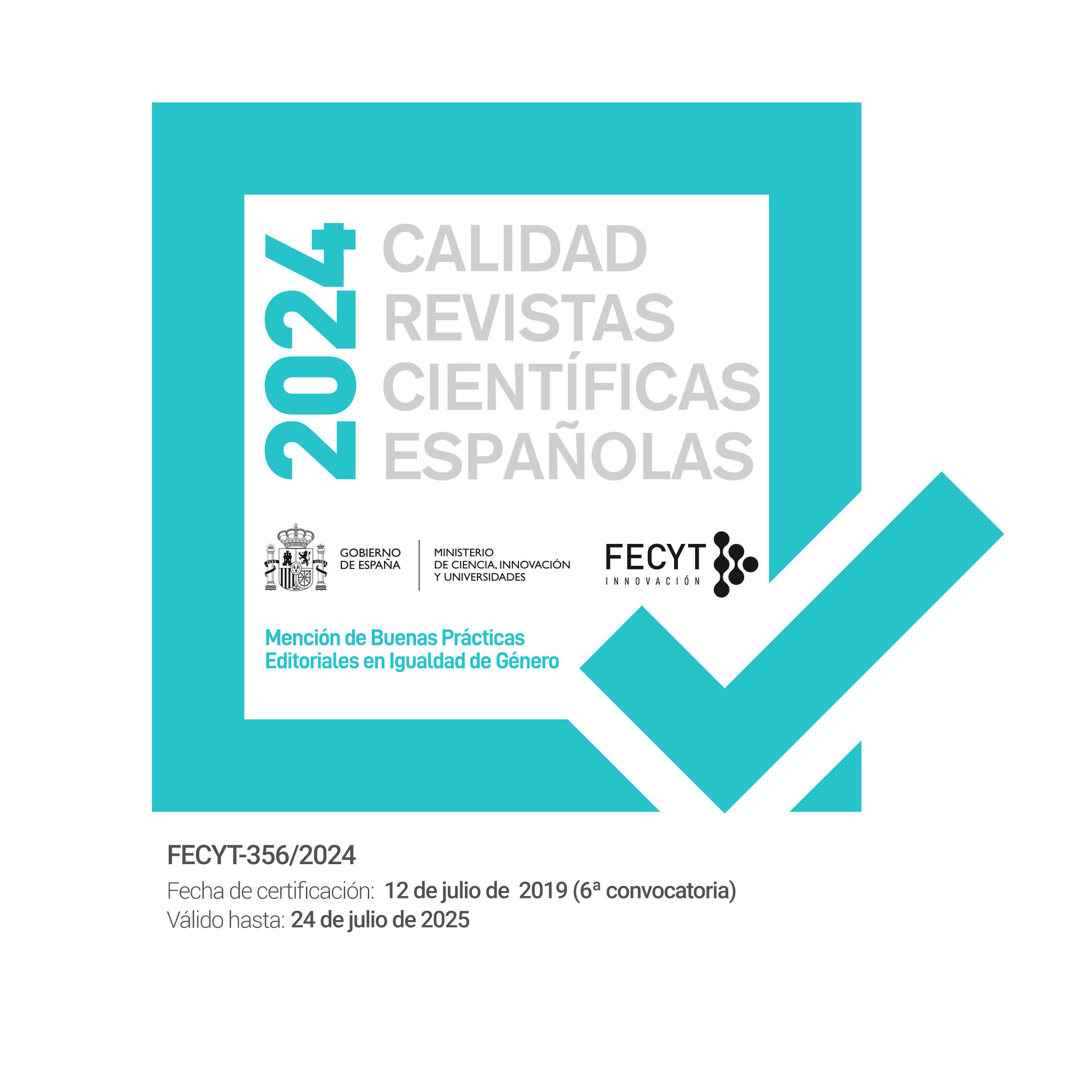La equidad retributiva en las Administraciones públicas españolas. Un estudio comparado
DOI:
https://doi.org/10.24965/gapp.11043Palabras clave:
dirección pública profesional, cuerpos superiores de la función pública, retribuciones, equidad interna y externa, carrera administrativaResumen
Este artículo analiza la competitividad salarial en la Administración española de los cuerpos superiores destinados en la administración general de los servicios centrales del Estado, de cinco comunidades autónomas y de cinco gobiernos locales.
Los conceptos retributivos que se manejan, complementos de destino y específico, se obtuvieron de las correspondientes relaciones de puestos de trabajo. Los estadísticos utilizados en la realización del diagnóstico salarial han sido la moda, la mediana, la media, los cuartiles y las retribuciones mínima y máxima identificadas en cada una de las Administraciones estudiadas.
Entre los principales resultados hay que destacar que el promedio y la mediana obtenidos de los complementos de destino y específico para cada uno de los niveles de los puestos revela la menor retribución de los funcionarios de la Administración General del Estado (AGE).
Entre las conclusiones sobresalen: la implantación del directivo público profesional debiera atender a los principios de mérito, capacidad y concurrencia; un mayor nivel de responsabilidad y de complejidad técnica debe corresponderse con un aumento retributivo suficientemente significativo; el estudio ha evidenciado, en general, la falta de competitividad de la AGE para retribuir a sus cuerpos superiores en relación con los funcionarios que realizan funciones similares en las Administraciones analizadas.
Descargas
Citas
ABC (2022, 4 de julio). Montero pretende limitar la movilidad y promoción de los funcionarios. https://www.abc.es/economia/abci-montero-pretende-limitar-movilidad-y-promocion-funcionarios-202207040841_noticia.html
Aberbach, J. D. (2003). The U.S. Federal Executive in an Era of Change. Governance, 16(3), 373-399. https://doi.org/10.1111/1468-0491.00221
Aberbach, J. y Rockman, B. (2000). Senior Executives in a Changing Political Environment. En J. Pfiffner y D. A. Brook (eds.), The Future of Merit: Twenty Years after the Civil Service Reform Act. (pp. 81-99). Widrow Wilson Center Press.
Adams, J. S. (1965). Inequity in social Exchange. En L. Berkowitz (ed.), Advances in Experimental Social Psychology (pp. 267-299). Academic Press.
Arenilla, M. (2021). Cuerpos y puestos en la función pública española. Diagnóstico, propuestas y líneas rojas. En J. Cantero (coord.), Continuidad versus transformación: ¿Qué función pública necesita España? INAP.
Arenilla, M. (2005). La vigencia de los modelos de gestión de los recursos humanos en las Administraciones públicas. Presupuesto y Gasto Público, 41, 211-225.
Arenilla, M. y Delgado, D. (2019). Una nueva función pública que fortalezca la confianza en las instituciones públicas. Revista Vasca de Gestión de Personas y Organizaciones Públicas. 16, 36-53. https://doi.org/10.47623/ivap-rvgp.16.2019.03
Arenilla, M., Llorente, J. y Redondo, J. C. (2022). Las retribuciones de las Administraciones públicas españolas. Revista de Administración Local y Autonómica, 18, 137-155. https://doi.org/10.24965/reala.11120
Baena, M. (1977). El poder económico de la burocracia en España. Información Comercial Española, 522, 12-21.
Baena, M. (1999). Élites y conjuntos de poder en España (1939-1992). Un estudio cuantitativo sobre parlamento, gobierno y administración y gran empresa. Tecnos.
Bekke, H. y Van deer Meer, F. (eds.) (2000). Civil Service Systems in Western Europe. Edward Elgar.
Beltrán, M. (1977). La élite burocrática española. Editorial Ariel.
Berman, E. M. (2015). HRM in Development: Lessons and Frontiers. Public Administration and Development, 35(2), 113-127. https://doi.org/10.1002/pad.1706
Castillo, F. A. (2002). El sistema retributivo en la función pública española. Marcial Pons.
Coccia, M. (2019). Intrinsic and extrinsic incentives to support motivation and performance of public organizations. Journal of Economics Bibliography, 6(1), 20-29. http://kspjournals.org/index.php/JEB/article/view/1795
Coccia, M. y Benati, I. (2018). Rewards in public administration: A proposed classification. Journal of Social and Administrative Sciences, 5(2), 68-80. http://kspjournals.org/index.php/JSAS/article/view/1648
Chiavenato, I. (2000). Administración de recursos humanos. McGraw Hill.
COMISIÓN PARA EL ESTUDIO Y PREPARACIÓN DEL ESTATUTO BÁSICO DEL EMPLEADO PÚBLICO (2005). Informe de la Comisión para el estudio y preparación del Estatuto Básico del Empleado Público. Recuperado de: http://www.uhu.es/ccoo/comunicados/2005_04_25_informe_comision.pdf
FEDECA (2018, 17 de septiembre). El Estatuto del Directivo Público. https://fedeca.es/noticias/fedeca-presenta-supropuesta-de-estatuto-del-directivo-p%C3%BAblico
Gómez, L., Balkin, D. y Cardy, R. (2016). Gestión de Recursos Humanos. Pearson.
Halligan, J. (2003). Civil Service Systems in Anglo-American Countries. Edward Elgar.
Herzberg, F., Mausner, B. y Snyderman, B. (1959). The motivation to work. Wiley.
Hood, C. y Lodge, M. (2006). The Politics of Public Service Bargains: Reward, Competency, Loyalty and Blame. Oxford University Press.
Hammerschmid, G., Van de Walle, S., Andrews, R. y Bezes, P. (eds.) (2016). Public Administration Reforms in Europe. The view from the top. Elgar.
Huseman, R. C., Hatfield, J. D. y Miles, E. W. (1987). A new perspective on equity theory: The equity sensitivity construct. Academy of Management Review, 12(2), 222-234. https://doi.org/10.5465/amr.1987.4307799
INAP. GRUPO DE ANÁLISIS Y PROPUESTA DE REFORMAS EN LA ADMINISTRACIÓN PÚBLICA (2021). 13 propuestas para reformar la Administración del Estado. INAP. https://www.libreriavirtuali.com/inicio/13-propuestas-para-reformar-la-Administraci%C3%B3n-del-Estado-EBOOK-p427983422
Jiménez, R. (2006). Directivos Públicos. Instituto Vasco de Administración Pública.
Jiménez, R. (2018). Alta dirección pública en España y en otros sistemas comparados. Politización versus profesionalización. Recuperado de: https://rafaeljimenezasensio.files.wordpress.com/2018/06/alta-direccion-publica.pdf
Jiménez, R., Villoria, M. y Palomar, A. (2009). La dirección pública profesional en España. IVAP-Marcial Pons.
Ketelaar, A., Manning, N. y Turkisch, E. (2007). Performance-based Arrangements for Senior Civil Servants OECD and other Country Experiences [OECD Working Papers on Public Governance, n.º 5]. OECD Publishing. https://doi.org/10.1787/160726630750
Kuperus, H. y Rode, A. (2008). Top Public managers in Europe. Management and Working Conditions of the Senior Civil Servants in the European Union Member States. European Institute of Public Administration.
Kuperus, H. y Rode, A. (2016). Top Public Managers in Europe. Management and employment in Central Public Administrations. European Institute of Public Administration. Ministry of the Interior and Kingdom Relations of the Netherlands. https://www.eupan.eu/wp-content/uploads/2019/02/2016_1_NL_Top_Public_Managers_in_Europe.pdf
Lah, T. J. y Perry, J. L. (2008). The Diffusion of the Civil Service Reform Act of 1978 in OECD Countries: A Tale of Two Paths to Reform. Review of Public Personnel Administration, 28(3), 282-299. https://doi.org/10.1177/0734371X08319950
Lee, K. H. y Raadschelders, J. C. N. (2008). Political-Administrative Relations: Impact of and Puzzles in Aberbach, Putnam, and Rockman, 1981. Governance, 21(3), 419-438. https://doi.org/10.1111/j.1468-0491.2008.00406.x
Lewis, D. E. (2008). The politics of presidential appointments: Political control and bureaucratic performance. Princeton University Press.
Losada, C., Albareda, A., Longo, F. y Férez, M. (2017). El empleo público en España: Desafíos para un estado democrático más eficaz. Instituto de Estudios Económicos.
Luxán, J. M. (2016). El impacto de la crisis en las retribuciones del sector público. Cuadernos de Gobierno y Administración Pública, 3-2, 143-169. https://doi.org/10.5209/CGAP.55085
Maeso, L. F. (2011). El personal directivo público en España (Su regimen jurídico antes y después del EBEP). Marcial Pons.
Maranto, R. y Hult, K. M. (2004). Right Turn?: Political Ideology in the Higher Civil Service, 1987-1994. The American Review of Public Administration, 34(2), 199-222. https://doi.org/10.1177/0275074004263352
Monereo, J. L. y Molina, C. (2008). Clases de personal al servicio de las Administraciones públicas. En J. L. Monereo (dir.). El Estatuto Básico del Empleado Público. Comentario sistemático. 9.
Neo, B. S. y Chen, G. (2007). People Development: Recruiting, Renewing and Retaining Leaders. En B. S. Neo y G. Chen (auts.). Dynamic Governance (pp. 317-382). World Scientific Publishing.
OCDE (2003). Managing Senior Management: Senior Civil Service Reform in OECD Member Countries. OECD Publishing.
OCDE (2005). Performance-related Pay Policies for Government Employees. OECD Publishing. https://doi.org/10.1787/9789264007550-en
OCDE (2014). Spain: From Administrative Reform to Continous Improvement. OECD Publishing. https://doi.org/10.1787/9789264210592-en
OCDE (2019). Government at a Glance 2019. OECD Publishing. https://doi.org/10.1787/8ccf5c38-en
Oelz, M., Olney, S. y Tomei, M. (2013). Igualdad Salarial. Guía introductoria. Organización Internacional del Trabajo. Recuperado de: https://www.ilo.org/wcmsp5/groups/public/---ed_norm/---normes/documents/publication/wcms_223157.pdf
Ortega, L. y Maeso, L. (2010). La alta dirección pública: Análisis y propuestas. INAP. http://193.146.45.100/libros/La_alta_direccion.pdf
Page, E. (2012). Policy Without Politicians: Bureaucratic Influence in Comparative Perspective. Oxford University Press.
Palomar, A., Sempere, A. V. y Quintanilla, R. Y. (2009). Comentarios a la ley 7-2007, de 12 de abril, del Estatuto Básico del Empleado Público. Aranzadi Thomson Reuters.
Porret, M. (2014). Gestión de personas. Manual para la gestión del capital humano en las organizaciones. ESIC.
Peters, B. G. (2013). Politicisation: What Is It and Why Should Care? En C. Neuhold, S. Vanhoonacker y L. Verhey (eds.), Civil Servants and Politics: A Delicate Balance (pp. 12-24). Palgrave Macmillan.
Peters, B. G. y Pierre, J. (eds.) (2001). Politicians, bureaucrats, and administrative reform. Routledge.
Peters, B. G. y Pierre, J. (eds.) (2004). Politicization of the Civil Service in Comparative Perspective: The Quest for Control. Routledge.
Pollitt, C. y Bouckaert, G. (2011). Public Management Reform: A Comparative Analysis. Oxford University Press.
Porter, L. W. y Lawler, E. E. (1968). Managerial attitudes and performance. R. D. Irwin.
Puchol, L. (1993). Dirección y gestión de recursos humanos. ESIC.
Raadschelders, J. C. N., Toonen, T. A. J. y Van der Meer, F. (eds.) (2007). The Civil Service in the 21st Century: Comparative Perspectives. Palgrave Macmillan.
Rainey, H. G. (2003). Facing Fundamental Challenges in Reforming Public Personnel Administration. En S. W. Hays y R. C. Kearney (eds.), Public Personnel Administration: Problems and Prospects (pp. 334-351). Prentice Hall.
Rainey, H. G. (2006). Reform Trends at the Federal Level with Implications for the States: The Pursuit of Flexibility and the Human Capital Movement. En J. E. Kellough y L. G. Nigro (eds.), Civil Service Reform in the States: Personnel Policy and Politics at the Subnational Level (pp. 33-58). State University of New York Press.
Selden, S. C. (2012). Global Trends in Human Resource Management. En B. G. Peters y J. Pierre (eds.), The SAGE Handbook of Public Administration (pp. 87-101). SAGE.
Taylor, J. y Westover, J. H. (2011). Job satisfaction in the public service. Public Management Review, 13(5), 731-751. https://doi.org/10.1080/14719037.2010.532959
Thiel, S. (2013). Managerialism and Politicisation in the Dutch Civil Service. En C. Neuhold, S. Vanhoonacker y L. Verhey (eds.), Civil Servants and Politics: A Delicate Balance (pp. 90-107). Palgrave Macmillan.
Varela, E. J. y Araújo, J. F. (2013). La dirección pública profesional en España y Portugal: Un análisis neoinstitucional. Revista de Gestao & Políticas Públicas, 1(3). 152-181. https://doi.org/10.13140/RG.2.1.4226.9284
Vroom, V. H. (1964). Work and Motivation. John Wiley and Sons.
Verhey, L. (2013). Civil Sevants and Politicians: Problems and Future Prospects. En C. Neuhold, S. Vanhoonacker y L. Verhey (eds.), Civil Servants and Politics: A Delicate Balance (pp. 25-44). Palgrave Macmillan.
William, B. Werther, J. R. y Keith, D. (1988). Administración de personal y de recursos humanos. McGraw Hill.
WORLD BANK (2005). Senior Public Service: High Performing Managers in Government. World Bank.
Descargas
Publicado
Cómo citar
Número
Sección
Licencia
Derechos de autor 2022 Gestión y Análisis de Políticas Públicas

Esta obra está bajo una licencia internacional Creative Commons Atribución-NoComercial 4.0.












